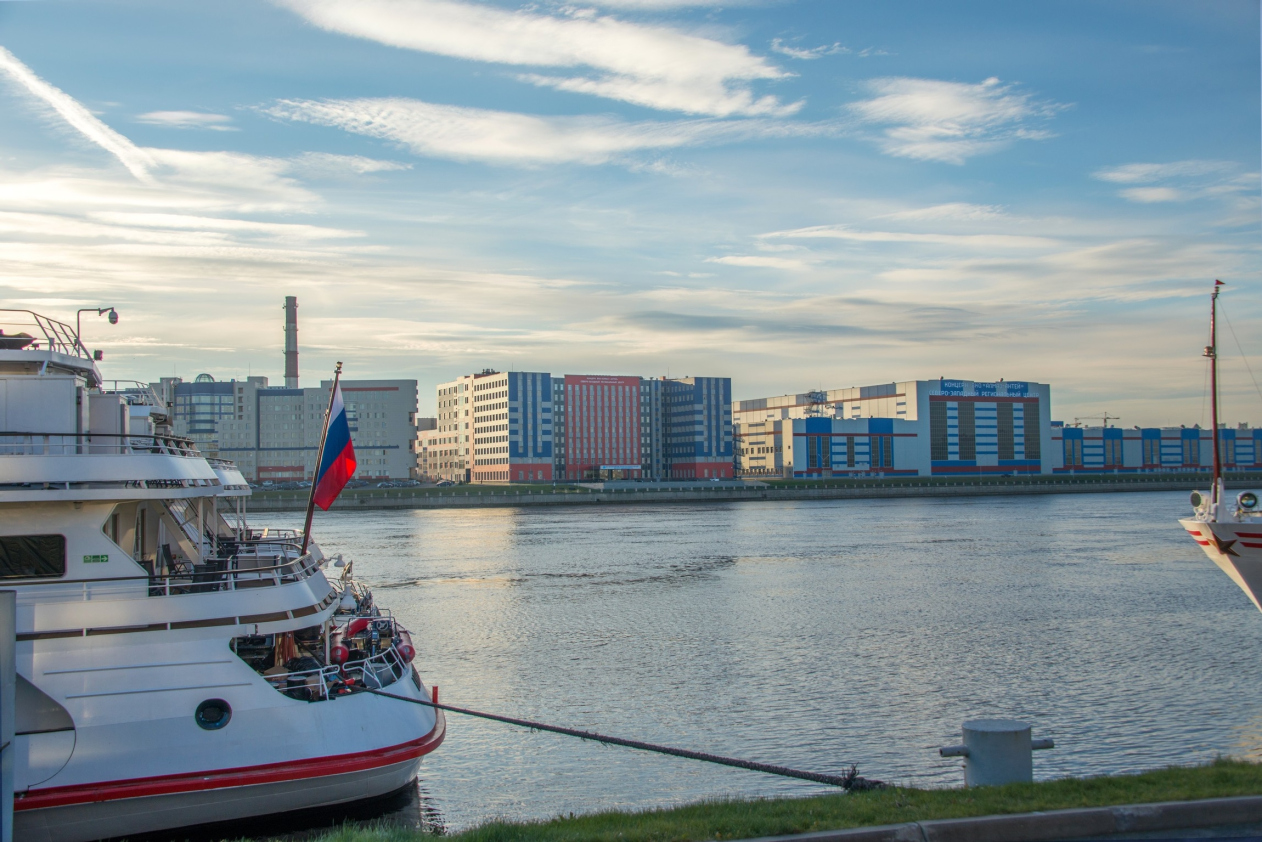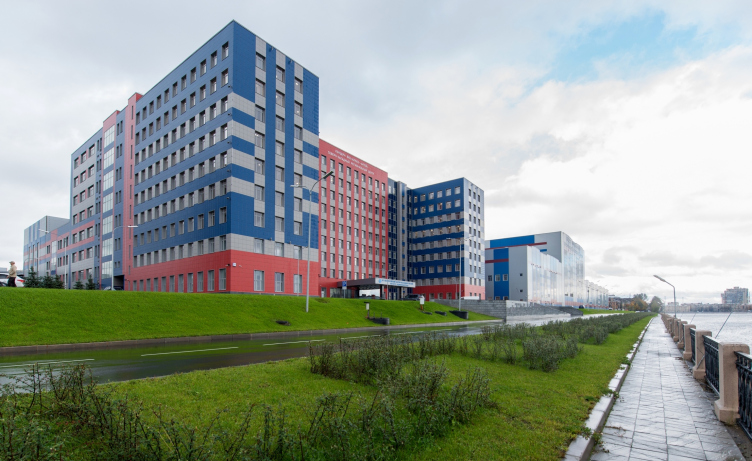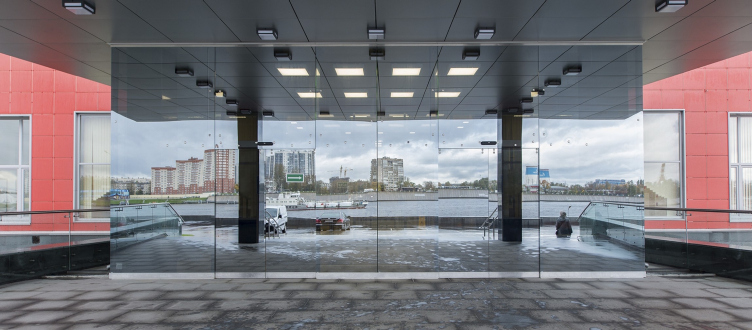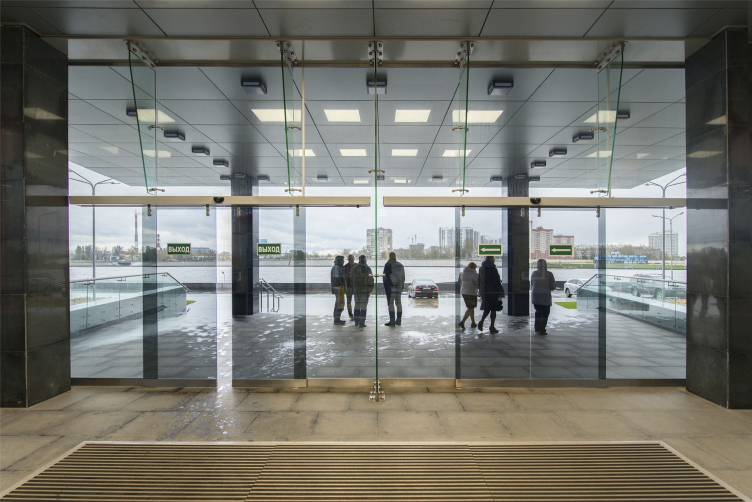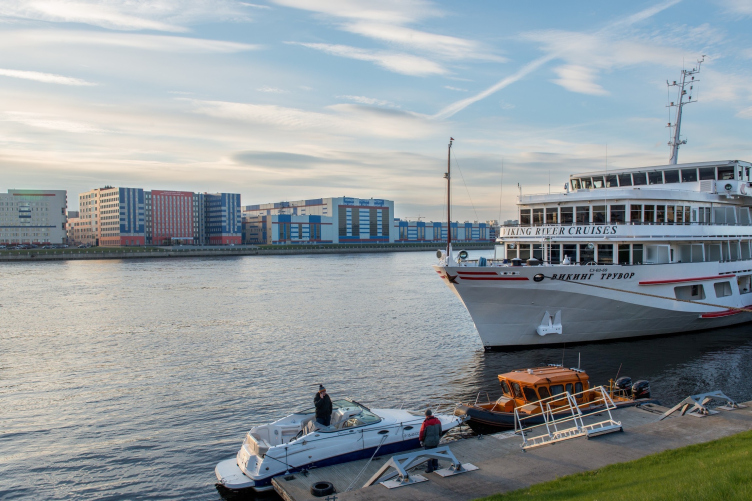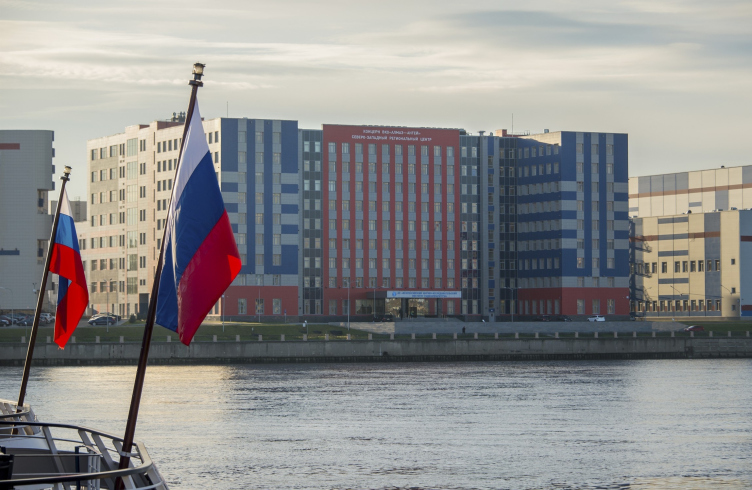The imposing edifice with a main building and two symmetrical wings appeared in the southeast part of the territory of the Obukhov plant as part of the plant complex. The laconic U-shaped volume opens up towards the Neva River; it stands out against the background of factory buildings thanks to its authors’ obvious intention to collect all the industrial buildings of this district into a single whole and organize them at least to some degree. The building’s main façade is accentuated by a granite porch underneath a protruding marquee.
The entire height of the main front side of the building is dissected with verticals and puts one in the mind of a giant portico in the spirit of Noah Trotsky. The overall classic composition with a basement, the main body, and the attic also refers us to the monumental style of the 1930’s. However, unlike its prototypes, the VNIIRA building is clearly coated with prominent ceramic granite. What we see instead of columns or pylons is a flat colorful pattern. The patriotic blue-red-white colors – the signature style of the client Almaz-Antey – were applied at his request to the entire factory complex.
All-Russian Research Institute for Radio Equipment. Construction, 2016 Designed by: Anatoly Stolyarchuk Architects, Studio 44. Photo © Margarita Yavein
All-Russian Research Institute for Radio Equipment. Construction, 2016 Designed by: Anatoly Stolyarchuk Architects, Studio 44. Photo © Margarita Yavein
Still, though, there was one exception that was made for the front porch: for its decoration, the architects used dark-brown ceramic granite and the noble-looking natural stone. The architect takes special pride in the high-technology seamless structural glazing with mirror-like sputter that reflects the water and the opposite bank. The same panoramic view unfolds from the inside of the tall spacious hall.
All-Russian Research Institute for Radio Equipment. Construction, 2016 Designed by: Anatoly Stolyarchuk Architects, Studio 44. Photo © Margarita Yavein
All-Russian Research Institute for Radio Equipment. Construction, 2016 Designed by: Anatoly Stolyarchuk Architects, Studio 44. Photo © Margarita Yavein
The building includes the institute laboratories, and the administration offices. The first floor consists of: the entrance group, the elevator hall, the security office, the master control room, the maintenance and engineering premises, as well as the laboratories and a cafeteria. The floors from five to seven are occupied by the laboratories. Higher up, there are the administrative offices. Behind the building right next to it, there is a production and storage facility.
Pristine but reasonably representative image of the new edifice, on the one hand, meets the requirements posed by the genre of an administrative factory building, and, on the other hand, is quite characteristic of its author’s signature styles. The architects whose formative years fell on the rigorous principles of the monumental soviet functionalism often demonstrate their cohesiveness to their teachers’ ideas. The straightforward austerity of the pristine style of the seventies looks today like noble simplicity, while its town-planning rationale makes one nostalgic for the sturdy soviet tradition where every little thing was done for a reason and nothing was left to chance.
All-Russian Research Institute for Radio Equipment. Construction, 2016 Designed by: Anatoly Stolyarchuk Architects, Studio 44. Photo © Margarita Yavein
All-Russian Research Institute for Radio Equipment. Construction, 2016 Designed by: Anatoly Stolyarchuk Architects, Studio 44. Photo © Margarita Yavein
The large scale of the façade turned to the Neva River is designed to be perceived as a single whole when viewed from the opposite side of the Oktyabrskaya Embankment and the Obukhovsky Bridge. The thought-out organization of the once-depressive are is also quite remarkable. Of course, set against the Neva panorama, such bright colors look nothing like “Saint-Petersburg”. This, however, not only has to do with the patriotic message of the client but is rather a common problem of the newly-built projects of this day and age, whose authors try to compensate for the paleness of the northern climate with the brightness of colors that they resort to. And still, the territory of the Neva waterfront is not just any sleeping-belt neighborhood. We only have to hope now for some veto power of some color regulations of Saint-Petersburg that we are expecting to be issued in December at the close of the young architectural and engineering contest for the best new housing projects “Saint-Petersburg Style of the XXI Century”.
All-Russian Research Institute for Radio Equipment. Construction, 2016 Designed by: Anatoly Stolyarchuk Architects, Studio 44. Photo © Margarita Yavein
All-Russian Research Institute for Radio Equipment. Construction, 2016 Designed by: Anatoly Stolyarchuk Architects, Studio 44. Photo © Margarita Yavein
